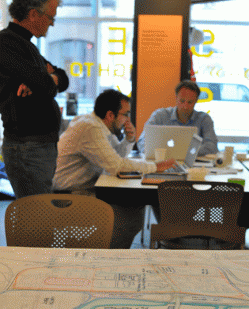Mill River District: An SCDA Update
The Mill River District is a 206-acre urban and light industrial area located at the heart of New Haven, Connecticut. The Mill River District contains many successful and diverse businesses attracted by the District’s low rents and strategic regional location. However, Mill River District also contains many neglected and underutilized parcels with significant environmental challenges related to past industrial uses and location along the Connecticut shore.
To address these challenges and build on the area’s native advantages, the Economic Development Corporation of New Haven (EDC), and the City of New Haven Department of Economic Development entered a public-private partnership with Mill River District businesses to create a development plan that will maintain the City’s industrial base, establish the District’s distinct identity, attract new businesses, and address sustainability challenges at the local and regional levels. This project is an opportunity to shift regional development patterns away from a suburban, big-box model toward a sustainable, urban model that takes advantage of New Haven’s population and workforce density as well as its regional connectivity.

A revised plan for the Mill River District. Designers Phil Erickson, Community Design + Architect, and Rob Dusenbury, Sustainable Watersheds, consult with Pedro Soto, Space-Craft Manufacturing, owner of a small business in this manufacturing district.
The Mill River District public-private partnership team members attended AAF’s Sustainable Cities Design Academy in San Francisco during April 2012 and presented their master planning work to date. The SCDA resource team, comprised of Phil Erickson, Community Design + Planning, and Rob Dusenbury, Sustainable Watershed Design, helped the New Haven team sort through proposed planning and implementation strategies to balance the City’s economic development goals with environmental goals. Their recommendations include identifying and enhancing physical and social connections to existing (and thriving) neighborhoods adjacent to the District through roadway and trail improvements, transit, landscaping, and signage, with emphasis placed on enhancing the pedestrian experience in the District. Also, with so much waterfront property throughout the District, the duo suggested developing a comprehensive plan for the waterfront that includes appropriate access points and land banks, based on the environmental sensitivity of these high flood zones. By land banking, the City can establish a riparian buffer zone that can mitigate flooding in the District and provide an open space benefit.
Kelly Murphy, New Haven’s Economic Development Administrator, says, “The lessons learned through SCDA played a large role in shaping the way we view the district and were foundational to the strategy we have laid out for its future.” Phase 1 Planning and Development Framework was released to the public and press at an event on July 24, 2012, and both the full document and executive summary are now posted on the EDC website.
More about the latest developments in the Mill River District is available here.
Featured image courtesy of City of New Haven Economic Development.


